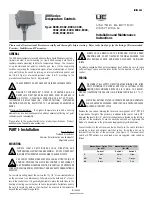
L-VIS User Manual
86
LOYTEC
Version 6.2
LOYTEC electronics GmbH
weight, and stretch are saved with the project, to allow the LWEB client to pick a
suitable font from the system it is running on. The difference compared to the
do
not embed
option is that there will be no pre-rendered font data replacing the
missing original font file. It is assumed that the font is installed on the client and
the project will be rendered as if the font was embedded. Anti-aliasing and other
features requiring the original font data will not be disabled.
NOTE:
If the original font source is not embedded in the project and is not assumed to be installed
on the client, the configuration software will analyze the project and pre-render all
required glyphs for the client to use as a replacement for the original font data. Since the
pre-rendered glyphs are bitmaps, no anti-aliasing will be available. Also, changes in text
layout may occur, since the pre-rendered font data will be missing kerning tables and other
meta-information required for optimal layout of specific character sequences. Complex
writing systems are not supported by pre-rendered fonts at all. The LCD preview will
reflect these differences immediately when the options are changed.
If available, the size of the original vector data will be shown in parenthesis following the
path to the source file. If the font source is embedded, some operations like resize and new
size can be executed without the need to locate the original file on the PC. In case the
original file is not embedded, it will be searched on the PC where the configuration
software is running. This mechanism is detailed in the next section.
8.8.2 Font File Location
When a project contains a user defined font, it is necessary to have access to the original
font file when working with the project. This is guaranteed as long as only the pre-installed
fonts are used, since they are located in a known place on every installation of the
configuration software. However, if fonts from an external source are used, they too must
be available whenever the project is loaded and modified and the user has to make sure to
deliver the font file together with the L-VIS project file, if the project is to be edited on a
different PC, where the font may not be available in the same location.
Most operations can be completed without access to the original file, when the font is
embedded in the project. If this is not the case, the original file has to be searched. To locate
the original font file, the configuration software will automatically try the following
locations in the given order until a suitable font is found:
The list of source files embedded in the project.
The full path from where the font was built the last time.
The directory containing the project file.
A
fonts
subdirectory of the directory containing the project.
The fonts directory of the configuration software installation.
The Windows system font directory.
If the font cannot be located in any of these places, the user is asked to provide an
alternative font file. If the font can be found, the project is updated with the newly located
font file to reflect any changes (a new version of the font may have been installed).
Based on the above search order, the easiest way to make sure that a project can be used on
any PC is to either embed the source file in the project, or store all custom fonts which are
used in the project in the same place where the project file itself is located.
















































